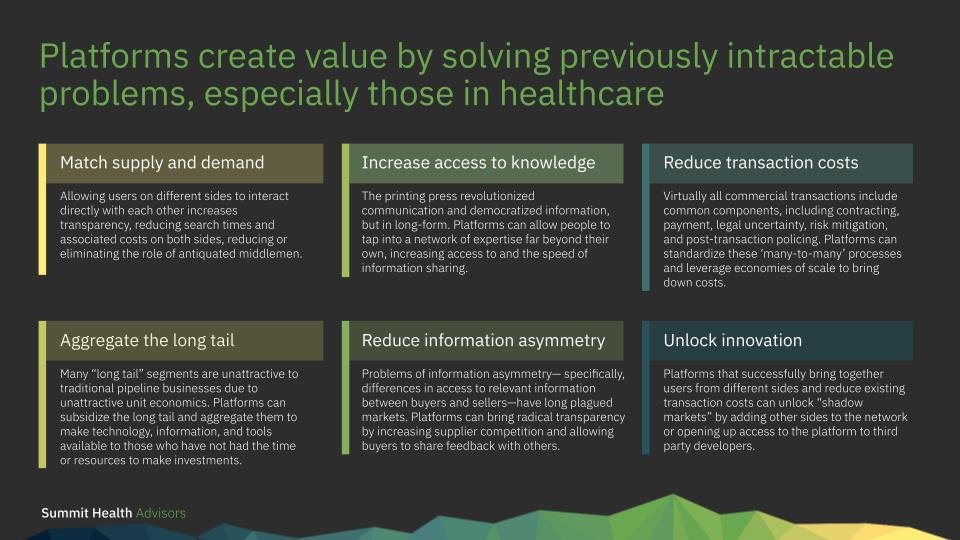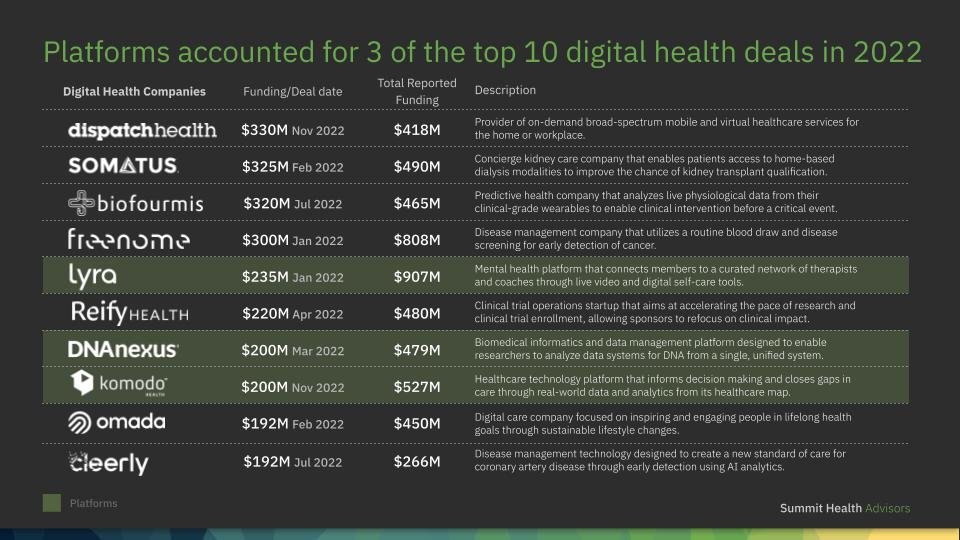2023 Healthcare Platforms Report: Making Bets? Healthcare Platforms Are Favored to Win
While digital health funding cooled significantly over the past year, healthcare platforms remain the preeminent business model for healthcare innovation and investment – growing faster, scaling quicker, and receiving higher valuations than non-platform (pipeline business model) digital health companies. Request Summit Health’s full 2023 Healthcare Platform Report here.
In a digital health investment landscape that saw fewer, smaller-sized deals in 2022, VCs and health tech companies alike have had to retool strategies, reprioritize investment decisions, and increasingly scrutinize how and where every dollar gets spent.
Making smart investment decisions in an uncertain economic climate requires both intuition and expertise, plus data and analysis. What does the data show to be one of the smartest bets for VCs and investors looking to back the next leader in healthcare innovation? Investing in healthcare platforms.
As John Halamka, MD, president of the Mayo Clinic Platform and longtime healthcare technology changemaker, notes in the 2023 Healthcare Platforms Report foreword: “Now that the system is largely digitized comes the much bigger task of connecting it all in meaningful ways. To do so requires new thinking - platform business thinking - in healthcare. Starting with the perspective of creating value by connecting and facilitating interactions, rather than building end-to-end solutions, can help address the biggest underlying challenges in healthcare today.”
Healthcare platforms as the dominant business model from multiple perspectives
With a unique business model and the ability to create new, novel, targeted networks, healthcare platforms are incredibly well-positioned to solve healthcare’s most complex and long-standing challenges. By connecting different constituents and allowing them to transact efficiently on a common technology infrastructure, for example, healthcare platforms are bridging gaps and making important connections in a fragmented healthcare system.
From a financial perspective, healthcare platforms are also proving to have the winningest business model – outpacing their pipeline digital health counterparts in both per-unit economics and market valuation, growing faster, scaling quicker, and being more efficient with capital and assets.
Healthcare platforms outperform pipeline digital health companies, including higher valuations in Series C and beyond
Another key finding from Summit Health’s 2023 State of Healthcare Platforms Report is that healthcare platforms are demonstrating the ‘flywheel’ of network effects at 2.4X their pipeline peers, which is also known as the valuation premium.
What is the flywheel effect? The flywheel refers to the key point in time for platforms where the network effects are so powerful, that growth happens quickly and continues to build over time. The more users that join a network, the more value it delivers to all, the more growth momentum it gains, and so on and so forth, until it reaches the key inflection point where growth begets growth, which is known as the flywheel.
What is the healthcare platform valuation premium? From a funding perspective, the valuation premium – whereby healthcare platforms are valued substantially higher than pipeline companies – tends to happen for healthcare platforms around Series C funding rounds. When healthcare platform companies go from seed round to Series B, platforms see similar valuations as their pipeline digital health competitors. But by Series C, D and beyond, platforms are valued 2.4X higher than pipeline digital health companies.
These findings mean that, if a VC firm invests in a healthcare platform that has a strong enough business concept to reach the flywheel, the firm can expect returns to be 140% higher than if they invested in a pipeline digital health company by a Series C funding round. Taking it one step further, if a seed investor puts $1 million into an average-performing pipeline company at an $8M pre-money valuation, without dilution and growing at the average pipeline IRR of 58%, they would see $5.2M in unrealized gains by a Series C round, which tends to happen around 4 years later. However, if a seed investor puts $1 million into an average-performing platform company with a $10M pre-money valuation, again without dilution and at the average platform IRR of 96%, they would see unrealized gains of $13.6M a bit sooner than 4 years.
Let’s look at Doximity as an example. Between 2019 and 2022, Doximity nearly doubled its users (1.1M to 2M). During the same period, Doximity increased its revenue from $86M to $344M, an astounding growth of 302% (while simultaneously increasing productivity as evidenced by revenue per employee growing 120% over the same period). Doximity was able to achieve this type of growth by growing its network of users and growing revenue per user (from $78 to $172) at the same time. This is an example of how demand-side economies of scale can be measured. Investors in early stage platforms should accordingly consider current and future potential unit economics, bearing in mind that the lifetime value of a customer can increase over time as the network grows.
What does the valuation premium mean for investors? All things equal, from an investment standpoint, healthcare platforms are the better bet for investors in the long run, and an even better investment when getting in from the get-go. While healthcare platforms can seem risky at seed stage, they are better positioned to deliver larger returns to investors post Series C. If you’re betting on healthcare innovation and can wait for the longer tail payoff, the bet should be on a platform.
Compared to years prior, healthcare platforms only account for 30% of the top 10 digital health investments in 2022, which were Lyra, Komodo Health and DNAnexus; however, all three companies had funding rounds of at least $200 million in 2022, where Lyra impressively snagged $235 million, bringing its funding to date to $907 million at a $5.58 billion valuation.
Full report details top performing healthcare platforms, opportunities, ones to watch
Building on last year’s analysis, the full 2023 State of Healthcare Platforms Report includes:
Guidance for both investors and digital health platform developers looking for the highest returns, growth potential, and business impact;
Rigorous analysis of the healthcare platform funding and investment landscape;
Financial review of some of the biggest healthcare platforms to date;
Strategic recommendations and executive perspectives top healthcare platform organizations (highlighted below).
By understanding how healthcare platforms grow and scale—and the requirements for success—platform companies, VCs and investors, and other potential partners will be in the best position to make the smartest, most strategic bets that stand to deliver the highest ROI while improving how healthcare operates for all.
Expert perspectives: Investors and healthcare platform leaders weigh-in
Launching, optimizing and scaling healthcare platforms is no easy task. In the 2023 report, healthcare platform leaders and health tech investors share what they see as the top challenges and opportunities in healthcare platform development, what companies are getting right and wrong, the power of network effects in healthcare, and guidance for other platform leaders and investors looking for the next flywheel.
Below is a small sampling of platform perspectives. Please see the full report for the complete Q&As.
Q. Investors: What’s most compelling about network effects-driven companies in healthcare?
Market opportunity: “If you look at the biggest companies in healthcare, they are network businesses, full stop. For example, what is the core product of insurance? It's a provider network, right? Yes, of course you have to have the ability to underwrite and all that kind of stuff. But effectively, the reason that they're able to have such durable market power is that they manage access to provider networks. Every member gives them more bargaining power as they contract with providers.” - Julie Yoo, General Partner, a16z
Create alignment: “There are many software business models, yet healthcare is a graveyard of good ideas with the wrong model or poor distribution. When solving for informational needs across multiple stakeholders, there is no higher value model than a well-designed two or three-sided network. True network effects are compelling because they drive stakeholder alignment, link product offering to value, and help achieve distribution in a way that is inexpensive and hard to replicate.” - Scott Barclay, Managing Partner, Insight Partners
Q. Platform experts: What is guiding you/your company? Where are you focused?
Align strengths: “A few things have been historically helpful for us at Amwell. The first is humility: to align what you are to what you are good at, and know your limits. For us, that was to be the pipes to enable others. We live to disappear. The second thing is discipline, to stay close to what you believe in. The third thing is impartiality, and the fourth is transparency.” - Roy Schoenberg, MD, President & CEO, Amwell
Solve problems: “We focus entirely on delivering the best possible product for our customers and build with empathy for their needs. Ultimately, it is our responsibility to make our product solve the most important problems our customers are facing, and make it seamless and delightful to use – the network effects that occur should be a symptom of that and serve to only further improve the customer outcomes.” - Nate Mazslak, Co-founder & CEO, Ribbon Health
Mission oriented: “I started with the mission. Putting patients first, creating win-wins, and removing waste from the system. And then I wanted it to be a large market opportunity. It also is important to think about what needs to be true for your business to actually work in the real world, in terms of the numbers. I’ve seen things funded that don’t make sense on a spreadsheet. They need to also make sense on a spreadsheet. That doesn’t mean it will work in the real world, but if it doesn’t make sense on a spreadsheet it’s not going to last.” - Oliver Kharraz, CEO, ZocDoc
Align interests: “Most network businesses are trying desperately to commoditize their supply, rather than aligning with the interests of that supply and treating them as differentiated. It's a very easy trap to fall into - to view doctors as interchangeable, to shortchange the power of correct matchmaking (especially for behavioral health), and to break your network in that way. I don't think we'll see commodity healthcare networks until we have a full paradigm shift simultaneously at the policy, technology, and social levels (i.e., AI becomes an effective substitute for some clinical or sub-clinical care).” – Brendan Keeler, Head of Product, Flexpa
Technology companies, healthcare platforms, investors and VC included in the report are: 23andMe, a16z, Activision, Ada, Adobe, Agilon Health, Airbnb, Aledade, Alma, Alphabet, Alumni Ventures, Amazon, AMD, Amwell, ApolloMed, Apple, Augmedix, Autodesk, Biofourmis, Blizzard, Booking Holdings, Brightline, Buoy Health, CanoHealth, Capable, CareBridge, Cerner, Cigna, Clarify, Cleery, Cleveland Clinic, Collective Health, Comcast, Commure, CVS Health, Define Ventures, DexCare, DispatchHealth, DNAnexus, Doordash, Doximity, eBay, Etsy, Flexpa, Freenome, General Catalyst, GoodRx, GV Partners, Health Catalyst, Health Gorilla, Homeward, Incredible Health, Innovaccer, Insight Partners, Intel, Intuit, January, Komodo, Lux, Lyra, Mastercard, Maven, Mayo Clinic Platform, Meta, Microsoft, Netflix, Oak HC/FT, Oak St. Health, Omada, One Medical, OptimizeRx, Optum Ventures, Owlet, Papa, Pearl, Phreesia, Plaid, Privia Health, Progyny, Proximie, PurpleLab, Quest Diagnostics, Redox, Reify Health, Rhyme, Ribbon, Salesforce, Scipher, Sesame, Shopify, Signify Health, Somatus, Stellar Health, Story Health, Tebra, Teladoc, Tesla, Texas Instrument, Thyme Care, Twitter, Uber, Visa, VMware, Vytalize, Walt Disney, Warby Parker, Waymark, WhatsApp, Wheel, Zocdoc, and Zoom.
Request a copy of Summit Health’s full 2022 Healthcare Platforms Report here, and please reach out to Summit Health partner Nick Webber or me (Evan Haas) for more information or with any questions. You can also schedule a meeting directly with Nick here or Evan here.




